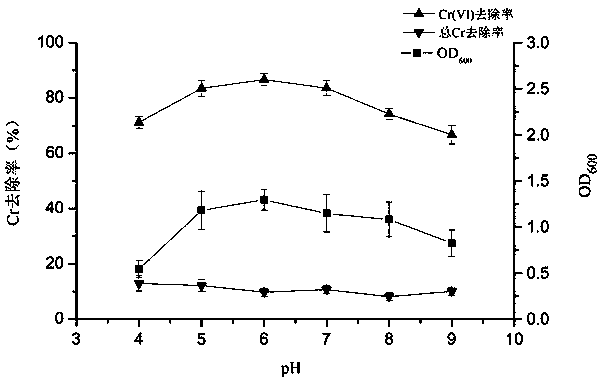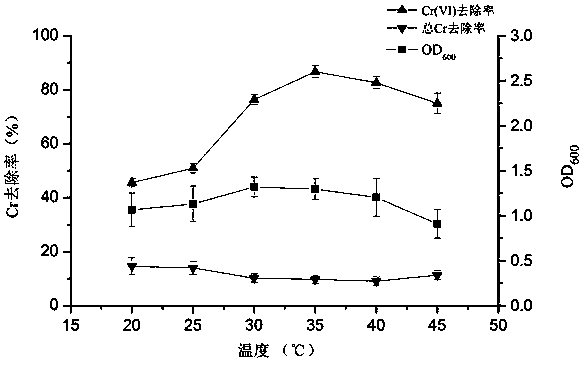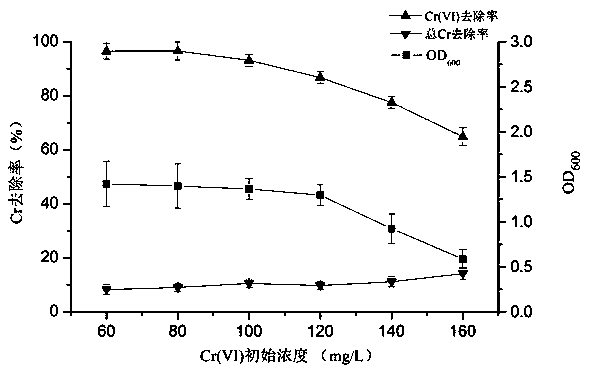Leersia hexandra Swartz endophytic bacterium capable of reducing hexavalent chromium and preparation method and application thereof
A technology of endogenous bacteria and hexavalent chromium, applied in biochemical equipment and methods, microorganism-based methods, bacteria, etc.
- Summary
- Abstract
- Description
- Claims
- Application Information
AI Technical Summary
Problems solved by technology
Method used
Image
Examples
Embodiment 1
[0021] Isolation and Screening of Chromium Reducing Endophytic Bacteria
[0022] First, the Lishihe plant was collected from the Phytoremediation Laboratory of the School of Environmental Science and Engineering, Guilin University of Technology, and an appropriate amount of healthy Lishihe stem was washed with water, soaked in 70% alcohol for 30 s under sterile conditions, and then soaked with 2.5 % sodium hypochlorite for 1 min, and finally rinsed with sterile water 6 times to remove the disinfectant attached to the surface of the material. Under aseptic conditions, use the sterile water rinsed for the last time to spread on the beef extract peptone solid plate medium. After cultivation, no microorganisms grow out, indicating that the surface is thoroughly disinfected. Under sterile conditions, take an appropriate amount of surface-sterilized root tissue, add 1 mL of 0.9% sodium chloride solution to grind thoroughly, take 1 mL of the grinding liquid and inoculate it in 100 mL...
Embodiment 2
[0026] Example 2 The initial pH of the J01 strain reduced Cr ( )Impact
[0027] The strain J01 stored on the slant of the test tube was activated by beef extract-peptone solid medium plate, cultured in a constant temperature incubator at 37 °C for 24 hours, and then 2 rings were picked and inoculated into a 250 mL Erlenmeyer flask containing 100 mL beef extract-peptone liquid medium. After 24 hours of shaking culture at 37 °C and 120 r / min, it was used as the seed solution.
[0028] The seed liquid was inoculated into the beef extract peptone liquid medium (filling volume 100 mL / 250 mL Erlenmeyer flask) containing Cr(VI) concentration of 120 mg / L according to 10% inoculum amount, with 2 M sodium hydroxide and After adjusting the pH with hydrochloric acid solution, eight layers of gauze were sealed, and placed on a constant temperature horizontal shaker at 35 °C for shaking culture at 150 r / min. After culturing for 48 h, an appropriate amount of culture fluid was sampled und...
Embodiment 3
[0029] Example 3 Temperature reduces Cr to J01 strain ( )Impact
[0030] The strain J01 stored on the slant of the test tube was activated by beef extract-peptone solid medium plate, cultured in a constant temperature incubator at 37 °C for 24 hours, and then 2 rings were picked and inoculated into a 250 mL Erlenmeyer flask containing 100 mL beef extract-peptone liquid medium. After 24 hours of shaking culture at 37 °C and 120 r / min, it was used as the seed solution.
[0031]The seed liquid was inoculated into the beef extract peptone liquid medium (100 ml) containing Cr(VI) concentration of 120 mg / L and pH 6.0 (adjusted with 2 M sodium hydroxide and hydrochloric acid solution) according to 10% inoculum amount. mL / 250 mL Erlenmeyer flask), sealed with eight layers of gauze, and placed on a constant temperature horizontal shaker at different temperatures for shaking culture at 150 r / min. After culturing for 48 h, an appropriate amount of culture fluid was sampled under steri...
PUM
 Login to View More
Login to View More Abstract
Description
Claims
Application Information
 Login to View More
Login to View More - R&D
- Intellectual Property
- Life Sciences
- Materials
- Tech Scout
- Unparalleled Data Quality
- Higher Quality Content
- 60% Fewer Hallucinations
Browse by: Latest US Patents, China's latest patents, Technical Efficacy Thesaurus, Application Domain, Technology Topic, Popular Technical Reports.
© 2025 PatSnap. All rights reserved.Legal|Privacy policy|Modern Slavery Act Transparency Statement|Sitemap|About US| Contact US: help@patsnap.com



